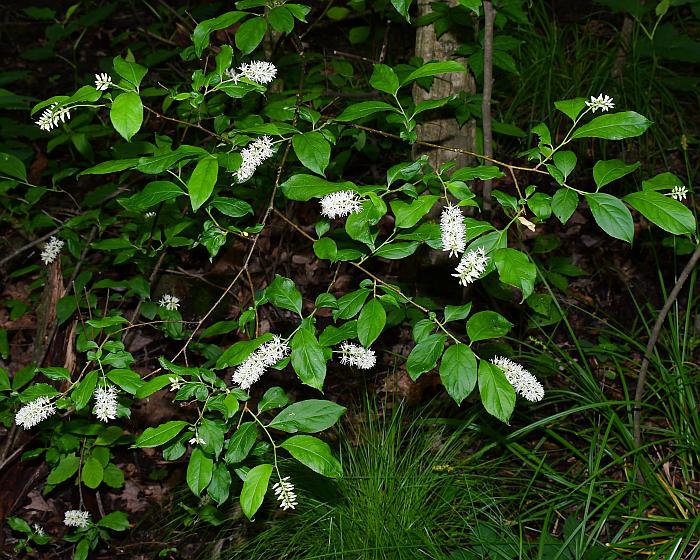Itea virginica L.
Virginia Sweetspire

Native
CC = 10
CW = -5
MOC = 7
© SRTurner
Itea virginica L.Virginia Sweetspire | |
 |
Native CC = 10 CW = -5 MOC = 7 |
© SRTurner |
|
Family - Iteaceae Habit - Shrubs 1-3 m tall. Stems - Bark gray to brown, smooth or breaking into thin scales with age. Stems loosely ascending with spreading branches, unarmed. Twigs finely hairy, the pith broken into chambers at maturity. Leaves - Alternate, simple, petiolate. Petioles 2-6 mm long. Stipules minute, shed as the leaves develop. Leaf blades unlobed, 3-13 cm long, 1.5-4.5 cm wide, elliptic to oblong-lanceolate, narrowed or more commonly tapered to a sharply pointed tip, narrowed at the base, pinnately veined, the margins sharply and usually finely toothed, the upper surface glabrous, the undersurface finely hairy along the veins.
Inflorescences - Racemes 4-22 cm long at branch tips, the axis hairy, the short flower stalks with inconspicuous small membranous bracts toward the base, these often shed during flower development.
Flowers - Perfect, actinomorphic, perigynous (nearly hypogynous), fragrant. Hypanthium small, saucer-shaped. Sepals 5, 1.2-1.4 mm long, narrowly triangular from a broad base, the slender tips often broken off by fruiting. Petals 5, 4-6 mm long, somewhat longer than the stamens, linear, somewhat incurved, white. Stamens 5, short, alternating with the petals, attached to the hypanthium, the anthers attached toward their midpoint. Pistil 1 per flower, of 2 fused carpels. Ovary superior, deeply grooved, densely hairy, with 2 locules, with numerous ovules, the placentation axile. Style 1 at flowering but persistent and separating into 2 styles at fruiting, the stigma capitate.
Fruits - Capsules, pendant at maturity, 7-10 mm long, 2-3 mm wide, the body narrowly elliptic in outline, tapered to the pair of short slender beaks, dehiscing along the groove between the carpels, with numerous seeds. Seeds 0.8-1.1 mm long, ovate to oblong-ovate in outline, somewhat flattened, the surface smooth or faintly and minutely pebbled, black, shiny.
Flowering - May - June. Habitat - Swamps, bottomland forests, acid seeps. Origin - Native to the U.S. Lookalikes - Leaves and inflorescences of Prunus serotina and Prunus virginiana are similar. Other info. - This shrub is uncommon in Missouri, known from only a few Bootheel counties. The Bootheel lies along the northwestern edge of the plant's natural range, which extends throughout the southeastern U.S. When in flower it is easily recognized by the combination of swampy habitat and cylindrical inflorescences of white flowers. The swampy habitat is also an important aid to identification. The photos above were taken in an area which could be described as a forested swamp, which was mucky enough to hinder navigation among the plants. Photographs taken at Holly Ridge Conservation Area, Stoddard County, MO, 5-29-2020 and 8-16-2021 (SRTurner). |